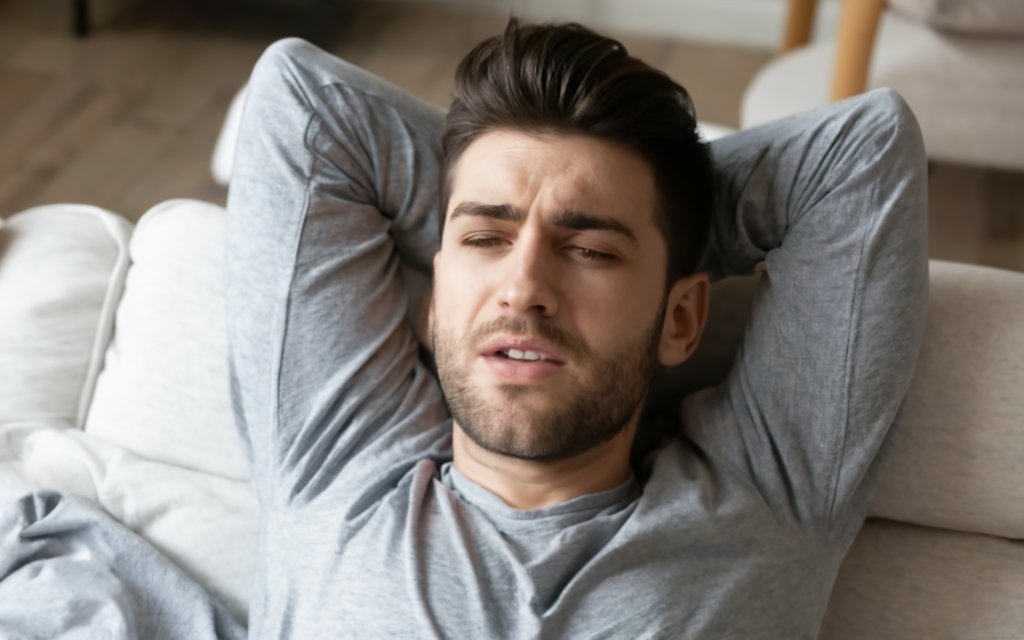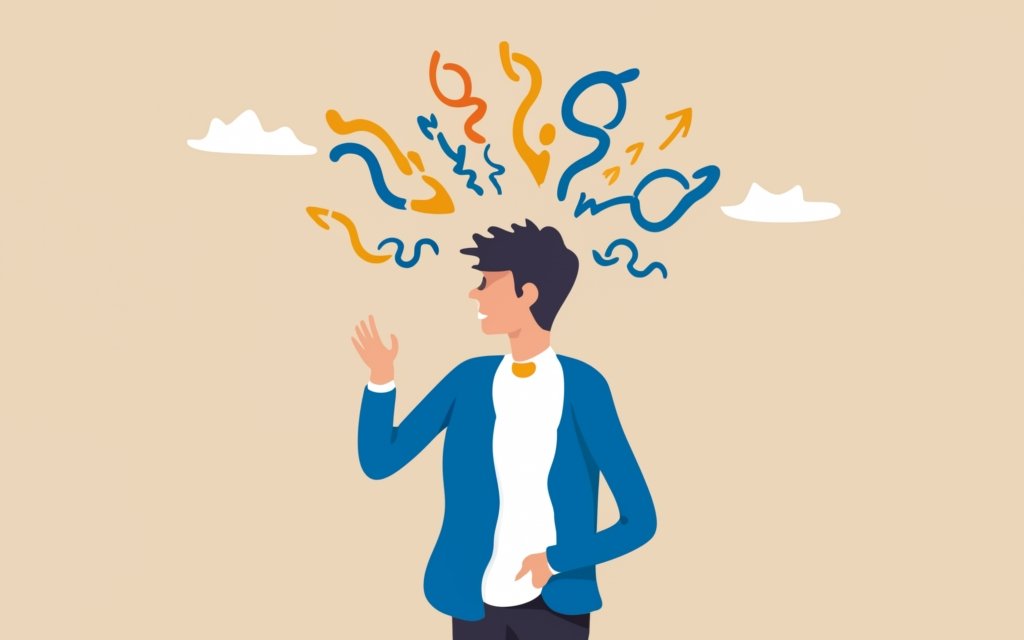Have you ever twitched or jerked suddenly as you were falling asleep? These startling sensations are surprisingly common experiences called hypnic jerks that over 70% of people encounter. Though harmless, understanding what causes these involuntary muscle contractions can help manage better sleep. Specifically, looking into reasons why do guys twitch in their sleep could provide insights into lifestyle factors influencing these disruptive sleep starts.
Hypnic jerks are myoclonic twitches occurring when transitioning from wakefulness to sleep, triggered by factors like stimulants, anxiety, or irregular sleep. By identifying lifestyle habits influencing sleep quality and adjusting pre-bedtime routines, hypnic jerks can be reduced for more restful sleep.
What are Hypnic Jerks?
Hypnic jerks, also termed sleep starts or hypnagogic jerks, are sudden, brief involuntary muscle twitches that happen as a person is falling asleep, which is why do guys twitch in their sleep. Typically benign, these forceful contractions jolt portions of the body, usually the legs, arms, or head. Hypnic derives from “hypnagogic”, defining the transitional state from wakefulness to sleep when they occur.
Despite the alarming sensations, hypnic jerks are normal. Ranging from mild to dramatic, over 70% of people experience these brief events at some point. For most people, hypnic jerks are infrequent and random, causing minor disturbance. However, frequent or intense jerks can disrupt sleep onset, negatively impacting sleep quality.
The Science Behind Hypnic Jerks
The precise neurological cause is uncertain, but scientific theories suggest hypnic jerks relate to the reticular activating system (RAS). This RAS region controls arousal and sleep-wake transitions. As the RAS system alternates between alertness and rest, miscommunications likely trigger these involuntary muscle contractions.
Essentially, as the body begins deeply relaxing during early non-REM sleep stages, the brain misinterprets this as falling. The RAS then reactively stimulates the nervous system and muscles to “catch” the body, causing a sudden jerk or twitch.
The Experience of Hypnic Jerks
Hypnic jerks range greatly, from mild to severe, meaning people describe the sensations differently. However, some common themes emerge in recounting the experience.
What Hypnic Jerks Feel Like
When a hypnic jerk occurs, people often report:
- A strong twitch or contraction, usually in the legs, arms, or head
- A falling or jolting sensation
- A flashing or loud auditory hallucination
- A faster heartbeat or quickened breathing after arousal
For some, hypnic jerks happen alongside vivid dream images that align with bodily reactions. For instance, people may dream they are falling as the body twitches.
The strength of muscle contractions varies, from small twinges to intense jolts that fully wake someone up. Even mild hypnic jerks can feel unsettling when transitioning towards sleep.
When Hypnic Jerks Happen
These involuntary events occur during early non-REM sleep stages as the body deeply unwinds. Specifically, hypnic jerks are most common when moving from wakefulness into light sleep. This explains why they occur right before falling asleep or during brief night wakings.
As sleep continues progressing towards deeper stages, hypnic jerks typically become less pronounced or disappear altogether. This corresponds with the body acclimating to relaxed non-REM sleep.
Causes of Hypnic Jerks
While hypnic jerks are normal, certain lifestyle factors appear capable of triggering or intensifying them. By identifying and moderating these influences, sleep quality may improve alongside reduced jerking activity.
Stimulants Disturb Sleep Transitions
Consuming stimulating substances close to bedtime seems to rouse the nervous system, interfering with the body properly slowing down for sleep.
Substances like caffeine, alcohol, nicotine, and medications act as nervous system stimulants. Their activating effects can carry over into early sleep stages, essentially over-alerting the brain and potentially prompting more hypnic jerks.
Stress and Anxiety Disrupt Sleep Relaxation
Letting go of stress and anxiety is key for restful sleep. However, uncontrolled worrying and tense muscles undermine the body’s ability to fully unwind at bedtime.
Research indicates elevated stress and anxiety often coincide with increased hypnic jerks. When the mind and body remain tense nearing sleep, involuntary movements may be more likely.
Irregular Sleep Heightens Fatigue
Inconsistent sleep schedules with shifted bedtimes challenge the body’s natural circadian rhythm. Too little high-quality sleep builds a sleep debt that breeds fatigue.
Sleep deprivation seems capable of aggravating hypnic jerks. Extreme tiredness essentially overtaxes the body, so sleep transitions become more difficult.
Exercise and Sleep
Interestingly, intense late-night exercise may also relate to more prominent hypnic jerks. Activities like weightlifting lead to exertion right before bed. Subsequently, the activated nervous system and muscles then struggle deeply relaxing into drowsiness.
This delayed onset of sleep may enable more involuntary twitching. Allowing exercise recovery time before sleep is best.
Health and Lifestyle Factors that Trigger Sleep Twitching
Since hypnic jerks occur during transitions into slumber, lifestyle habits affecting sleep quality also likely influence jerking frequency and intensity. By identifying and adjusting behaviors that undermine sleep health, reductions in “why do guys twitch in their sleep” seem achievable.
Sleep Deprivation
Insufficient sleep is the most common lifestyle factor provoking poor sleep health. Chronic sleep deprivation breeds an unrelenting sleep debt that disrupts sleep continuity and depth.
In this fatigued state, the body struggles entering deeper non-REM and REM sleep stages. The perpetual sleep deprivation essentially breeds hypersensitivity when transitioning into sleep. The frequently interrupted process manifests as more pronounced hypnic jerks.
Caffeine and Sleep
Consuming caffeine close to bedtime allows stimulant effects to persist as the body unwinds for sleep. Caffeine blocks adenosine reception, a sleep-promoting chemical in the brain. So despite feeling tired, the brain remains partly stimulated by caffeine nearing bedtime.
This chemical alertness coupled with physical fatigue likely aggravates the neural mismatch between mind and body that triggers hypnic jerks.
Stress, Anxiety and Sleep
Letting go of stress and anxiety is instrumental for restorative sleep. However, unmanaged worrying coupled with tense muscles undermine relaxation needed for deep non-REM sleep.
Research confirms people experiencing frequent stress and anxiety often have increased hypnic jerks when attempting sleep. Unchecked mental and physical tension conflict with the process of unwinding into slumber, prompting more involuntary movements.
Exercise Timing and Sleep
Consistent exercise helps regulate sleep-wake cycles and deepen sleep. However, intense late-night workouts seem to delay sleep onset and slow muscle relaxation. Consequently, hypnic jerks may become more noticeable after strenuous evening exercising.
Ideally, longer workouts should finish 3-4 hours before bedtime allowing the body to recover. Shorter exercise sessions may require slightly less recovery time.
Managing Hypnic Jerks
While hypnic jerks are harmless, frequent or severe jerking can disturb sleep. By cultivating healthy sleep habits and modifying lifestyle factors related to twitching, better sleep with fewer sleep starts seems achievable. The question of “why do guys twitch in their sleep” is an important one to address through healthy lifestyle changes to reduce sleep disruption.
Healthy Sleep Habits
Establishing a regular sleep-wake cycle helps synchronize the body’s circadian rhythms to the 24-hour day. Maintaining this consistent schedule by going to bed and waking around the same time trains the body to expect sleep at those times.
Practicing good sleep hygiene further bolsters sleep health by controlling stimuli and behaviors affecting sleep quality. Key tips include:
- Limiting caffeine, alcohol and heavy foods before bedtime
- Establishing a calming pre-bed routine
- Making the bedroom comfortable and dark
- Reducing electronics use at night
Together these changes regulate the sleep environment, easing the transition between alertness and rest.
Adjusting Lifestyle Factors
Since lifestyle habits greatly impact sleep, modifying certain behaviors may lessen twitching events:
Curb caffeine intake: Caffeine’s stimulating effects linger for hours, so avoid it at least 5-6 hours before bedtime.
Minimize alcohol: Drinking can fragment sleep, worsening transitions into deeper stages.
Time exercise: Intense training too near bed may hinder unwinding. Finish workouts at least 2-3 hours before sleep.
Manage stress: Unchecked anxiety and tension interfere with rest. Try calming practices like yoga, meditation, or counseling.
Prioritize sleep: Allow enough time for plentiful rest nightly instead of accumulating a sleep debt.
Myths and Misconceptions About Hypnic Jerks
Despite being a common phenomenon, myths abound concerning hypnic jerks and sleep. Dispelling these misconceptions is important for proper perspective.
Myth: Hypnic jerks indicate an underlying disorder
Fact: Hypnic jerks are a natural phenomenon, not symptomatic of health conditions. While worrisome, they are harmless.
Myth: Medications treat hypnic jerks
Fact: Hypnic jerks require no treatment since they are benign. Medications would address associated problems like insomnia or anxiety instead.
Myth: Hypnic jerks mainly affect older adults
Fact: People of all ages experience hypnic jerks, though they may become more noticeable with age.
Myth: Hypnic jerks signify poor sleep
Fact: These brief twitching events hold little meaning for overall sleep quality. Good sleep is still possible.
By understanding the true nature of hypnic jerks, any associated concerns can be appropriately calmed.
Theories Behind Hypnic Jerks
While hypnic jerks are common, researchers remain uncertain what causes these involuntary muscle contractions when falling asleep. Multiple theories attempt explaining the mechanisms behind hypnic jerks.
One theory suggests as the body deeply relaxes towards early non-REM sleep, the brain misinterprets this as falling. The reticular activating system then reactively stimulates the muscles to “catch” the body, resulting in a hypnic jerk.
Another hypothesis proposes hypnic jerks are a protective reflex triggered by natural bodily changes when transitioning into slumber. For instance, decreases in blood pressure and temperature coupled with muscle relaxation may prompt a neural reflex that presents as a bodily contraction.
Overall, the lack of definitive cause confirms hypnic jerks are a common, random physiological event for most people. They do not inherently indicate underlying health issues.
When to Seek Help for Hypnic Jerks
Despite typically being harmless, severely frequent or intense hypnic jerks may require medical consultation.
Seeking medical advice is reasonable if jerks:
- Consistently disrupt sleep onset
- Cause distress or anxiety preventing sleep
- Increase in frequency and intensity over time
- Occur alongside other verbal or physical sleep disruptions
In these scenarios, sleep studies may be warranted to assess for other potential sleep disorders exacerbating the jerking. Doctors may also evaluate factors like medication side effects or health conditions that commonly provoke sleep disruptions in general.
Tips for Lessening Hypnic Jerks
While no definitive treatment exists for hypnic jerks specifically, people can take constructive steps to potentially reduce jerking activity:
Improve sleep hygiene through consistent bedtimes, limited naps, and calming pre-bed routines.
Reduce stimulant intake like caffeine, alcohol, or nicotine several hours before bed.
Manage stress and anxiety through counseling, meditation, medication, or other evidence-based approaches.
Moderate evening exercise by avoiding intensive late-night workouts that overstimulate the nervous system and muscles.
Though simple lifestyle measures, these proactive changes may curb factors that commonly aggravate hypnic jerks for improved sleep quality.
Conclusion
Hypnic jerks are involuntary muscle contractions frequently occurring when transitioning into light sleep. Though alarming, these brief twitches are a common and benign phenomenon. Still, lifestyle habits like stimulant intake, inconsistent sleep, anxiety, and exercise timing appear capable of aggravating jerking intensity and frequency. Understanding why do guys twitch in their sleep requires examining how factors like sleep deprivation, stress, caffeine intake, and late-night workouts may relate to or trigger the muscle contractions guys experience when falling asleep.
By cultivating healthy sleep hygiene practices and regulating behaviors that undermine sleep relaxation, reductions in hypnic jerks seem achievable. With good sleep habits, the body can smoothly progress through transitional arousal states towards deep restorative sleep. Ultimately, addressing lifestyle factors offers a constructive approach for managing hypnic jerks and improving sleep quality.



